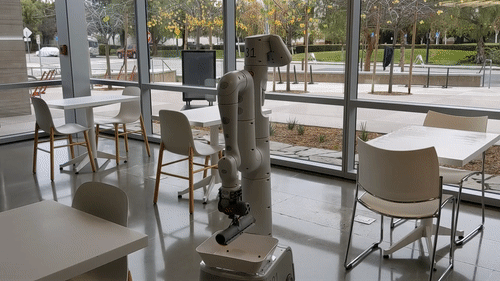 EMERGING TECH
EMERGING TECH
 EMERGING TECH
EMERGING TECH
 EMERGING TECH
EMERGING TECH
Alphabet Inc.’s X research lab today provided an update about its Everyday Robots project, which aims to develop robots capable of performing day-to-day tasks such as tidying chairs.
The X research lab explores emerging technologies that fall outside the main focus area of parent Alphabet. Before the Everyday Robots project, the lab ran the autonomous driving initiative that would eventually become Waymo LLC. X has also developed a variety of other technologies ranging from high-altitude internet balloons to delivery drones.
Everyday Robots is an effort by the lab to develop robotic systems that can carry out chores with the help of artificial intelligence. X researchers are using multiple AI techniques as part of the project. “Using a combination of machine learning techniques like reinforcement learning, collaborative learning, and learning from demonstration, the robots have steadily gained a better understanding of the world around them and become more skilled at doing everyday tasks,” Everyday Robots Chief Technology Officer Hans Peter Brøndmo detailed in a blog post today.
So far, X has developed more than 100 prototype systems as part of the project. Some of the robots are deployed at the lab’s offices, where they help clean the cafe and check if meeting rooms are missing chairs or need to be tidied. Each system carries out chores using a robotic arm that can open doors, push in chairs and remove cups left on a table.
The versatility of X’s robots is to a large extent the result of their onboard AI software. The AI determines the best way to carry out a task by analyzing environmental data collected by a robot’s onboard sensors.
The homegrown AI technology that X uses as part of the Everyday Robots project has significantly increased in sophistication over the years. “Back in 2016, when we weren’t using simulation and were using a small lab-configuration of industrial robots to learn how to grasp small objects like toys, keys and everyday household items, it took the equivalent of four months for one robot to learn how to perform a simple grasp with a 75% success rate,” X’s Brøndmo detailed. “Today, a single robot learns how to perform a complex task such as opening doors with a 90% success rate with less than a day of real-world learning.”
X researchers are using several methods to increase the efficiency with which the robots can carry out tasks. One of those methods involves training the robots’ AI software in simulated environments. In the autonomous vehicle ecosystem, Google LLC sister company Waymo and its competitors are using similar techniques to enhance their driving systems.
Additionally, X researchers have been working on ways of teaching the robots to apply learnings they glean from one task to other workflows. The more tasks a robot can learn on its own, the less time and effort has to be invested in training the onboard AI algorithms, which simplifies software development.
To advance its research, X will soon begin deploying its robots in some of Google’s Bay Area offices. The lab intends to expand the scope of the project gradually. “Over time, we’ll be expanding the types of tasks they’re doing and the buildings where we operate,” Brøndmo wrote.
Support our open free content by sharing and engaging with our content and community.
Where Technology Leaders Connect, Share Intelligence & Create Opportunities
SiliconANGLE Media is a recognized leader in digital media innovation serving innovative audiences and brands, bringing together cutting-edge technology, influential content, strategic insights and real-time audience engagement. As the parent company of SiliconANGLE, theCUBE Network, theCUBE Research, CUBE365, theCUBE AI and theCUBE SuperStudios — such as those established in Silicon Valley and the New York Stock Exchange (NYSE) — SiliconANGLE Media operates at the intersection of media, technology, and AI. .
Founded by tech visionaries John Furrier and Dave Vellante, SiliconANGLE Media has built a powerful ecosystem of industry-leading digital media brands, with a reach of 15+ million elite tech professionals. The company’s new, proprietary theCUBE AI Video cloud is breaking ground in audience interaction, leveraging theCUBEai.com neural network to help technology companies make data-driven decisions and stay at the forefront of industry conversations.